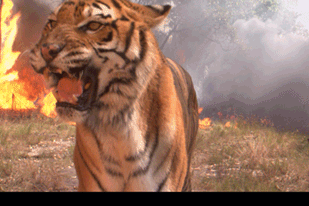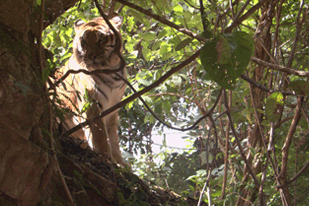Mary Ann Skweres discusses the VFX challenges of Two Brothers with supervisor Freric Moreau, who required fluid, seamless integration of tigers and actors.

Universals family-friendly adventure drama, Two Brothers, is a story of two infant tiger cubs, Koumal and Sangha. Separated from their parents and each other, the siblings are taken into captivity one to a life of cruel beatings in a circus while the other eventually lands in the hands of a man determined to turn him into an aggressive prizefighter. Years later they are reunited as enemies by explorer Aidan McRoy (Guy Pearce, Memento) who inadvertently forces them to fight each other. Director of the acclaimed animal epic The Bear (1988), Jean-Jacques Annauds stunning animal direction and the exotic period setting of 1920s French colonial Indochina make Two Brothers another step in the directors continuing quest to explore the nature of nature. Told through the eyes of its four-legged protagonists, the film was shot in the jungles of Thailand and Cambodia and extensively in Cambodian temples in Siem Reap, including Angkor Wat, Bantey Srei and Beng Melea. The filming was long and arduous spanning four months in length. The filmmakers not only faced the challenges of a distant location but the difficulties and unpredictable nature of working with extremely dangerous wild animals.

Visual effects helped solve the problems. VFXWorld corresponded with French visual effects supervisor, Fréderic Moreau, in an attempt to discover the creative inspiration, technology and techniques used to overcome the challenges posed by the film.
Mary Ann Skweres: What was the most challenging aspect of the visual effects work in Two Brothers?
Fréderic Moreau: There are 550 visual effects shots [by Éclair] in director Jean-Jacques Annauds Two Brothers, in other words one third of the movie. A lot of the vfx shots were done for obvious security reasons tigers and people were systematically shot separately. Because of the unpredictable nature of the animals, the tigers themselves were often shot separately the baby tigers and adults would typically be shot separately. Our challenge was seamless realistic integration [of the tigers and actors] to give the impression of fluidity and to never give away the [visual effects] tricks to the audience.

MS: Tell me about how you worked with the tigers. When did you use the animatronic animal and when did you use the real animal?
FM: A huge area surrounded by security barriers was devoted to the tigers. Inside the area, locked in cages, was the crew. Thierry Leportier, the famous trainer, and his team were the only ones allowed to work in direct contact with the tigers. They provided shots and multiple passes. The problem was not only to erase the trainers, devices, cameras and cages from the set, but also to restore the natural environment that the tigers enjoyed destroying between passes. To keep a consistent light as light is changing every minute when in the jungle turned out to be another challenge in achieving seamless integration [of all elements of the shot]. Months before principal photography began, we filmed the tigers against bluescreens in order to have a library of tiger expressions, which have been of a great help. Animatronics were used for close ups of direct interactions with actors or for the baby tiger carried in its mothers mouth. Sometimes, we used animatronic body parts composited over the real tigers; for example, when the mother tiger is feeding her babies.


MS: Did you use computer-generated tigers at all or use CG in combination with the real and animatronic tigers?
FM: We used very little CG for the tigers. It was only used in combination with live plates and animatronics.
MS: How did the actors work with the tigers?
FM: As they were not allowed to play or interact with the tigers (its very, very dangerous), Jean-Jacques Annaud directed the actors in a sort of playback using video and targets for action synchronization.
MS: What other types of effects such as CG, matte painting and rotoscoping did you use in the film?
FM: We had matte paintings for large shots, such as the forest, country, mountains, river and circus. CG was used for the flocks of bats and a butterfly. We also added a fish in an aquarium, since the real one appeared to be camera shy. We also had to enhance a lot of the final fire sequence with real and CG flames and smoke. In this kind of shooting, rotoscoping is an unavoidable necessity.

MS: How were visual effects used to enhance or modify the actual Asian locations?
FM: Locations, enhanced with production design, were mostly perfect. However a number of matte paintings and other subtle modifications contributed to creating the atmosphere of the film and gave a sense of continuity between sequences.
MS: What is your favorite shot? What do you consider your best work?
FM: There are a lot of shots that I like, sometimes because they were very hard to create and now look so simple. My favorite could be the last shot of the film which turned out peaceful and beautiful while the reality of the shooting was crowded with ever changing lighting conditions and the restless tigers never staying on their marks.
MS: How did your work support the story and allow it to be made?
FM: We always have to remember that wild animals never do exactly what you ask from them and in the case of the tigers, can be extremely dangerous and unpredictable. You can sometimes fool yourself into thinking that they have developed the habit of being tame with the cinema crews. Forget it! They are fast and you always have to stay at a safe distance away from them. Practically, this translates into a lot of multiple passes and rotoscoping to tell the story.
MS: Who are the key members of your crew i.e., animation director, lighting, pipeline and what are their contributions?

FM: Ive had a wonderful and talented crew on this movie. Philippe Soeiro, a top French compositing artist, supervised all the artistic aspects and even indulged in compositing some challenging shots himself. Christian Rajaud supervised the entire shoot on location in Cambodia, Thailand and France until the very last day while we were already working on the effects shots in production. We joined him to supervise the most complex sequences. Sarah Flament brilliantly coordinated the work between all the digital artists and editorial. I have had a crew of fifteen very motivated digital artists, all of whom worked with precision and in a team spirit. Because of co-production issues, 40 shots were made in England by a very competent crew, which we selected, supervised, and enjoyed working with. We developed a very constructive working relationship with editorial and the director that has allowed us to effectively respect delivery delays and budget without artistic compromises. Efficiency in a good spirit could be the motto of this production.
MS: Is there anything else that youd like to share with me?
FM: Since all the subsequent digital grading [color timing] was also done at Éclair lab, it was very easy to remain strongly involved in the whole postproduction process until the very end of the project. I thoroughly enjoyed that.
Mary Ann Skweres is a filmmaker and freelance writer. She has worked extensively in feature film and documentary post-production with credits as a picture editor and visual effects assistant. She is a member of the Motion Picture Editors Guild.







